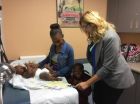Majority of older breast cancer patients use hormone treatment
2014-06-16
(Press-News.org) WASHINGTON — One of the most comprehensive looks at the use of hormone therapy in women over 65 with non-metastatic breast cancer found some welcome news. Except for frail patients, most participants in the large study complied with their oncologists' recommendations to treat their estrogen-positive breast cancer with hormone therapy — either an aromatase inhibitor or tamoxifen. These drugs prevent tumors from using estrogen to fuel growth.
But the study, reported online June 16th in the Journal of Clinical Oncology, also found that non-white women were much more likely to not have therapy.
"Women 65 years of age and older comprise about half of patients with breast cancer, but some studies have suggested this group initiates therapy less often and discontinues treatment more frequently than younger or middle aged women," says the study's lead author, Vanessa B. Sheppard, PhD, associate professor of oncology and assistant director of health disparities research at Georgetown Lombardi Comprehensive Cancer Center.
"We found a more positive picture of use — although more than half of patients discontinued use before the five years of recommended treatment, non-initiation of starting treatment was only 14 percent," she says. "This is reassuring, as it's important for women to give themselves a chance for the best outcome possible, regardless of their age."
The seven-year study was conducted at 78 institutions and clinics in the U.S., enrolling 1,062 elderly women ages 65 to 91 with locally invasive cancer that had not spread.
Women in the study judged to be frail or even "prefrail" may well be justified in not starting treatment for their breast cancer compare to women who are more robust or less frail, she says. "It may be that these women, with the concurrence of their physicians, felt they would not live long enough to benefit from the therapy given competing health conditions, and they also may have wanted to avoid any toxicities from treatment," Dr. Sheppard says.
Researchers also found that the discontinuation rate (stopping therapy before five years) was 51.5 percent and that the risk of discontinuation was higher with increasing age and lower for advanced stages of the disease. "This rate of discontinuation is about the same seen in some other studies," she says.
INFORMATION:
The study was funded by grants from the National Cancer Institute, National Institutes of Health (CA84131, CA124924, CA127617CA96940CA154848, CA31946, CA33601, 369901) by Georgetown Lombardi Comprehensive Cancer Center and by a grant to support patient accrual from Amgen Inc.
About Georgetown Lombardi Comprehensive Cancer Center
Georgetown Lombardi Comprehensive Cancer Center, part of Georgetown University Medical Center and MedStar Georgetown University Hospital, seeks to improve the diagnosis, treatment, and prevention of cancer through innovative basic and clinical research, patient care, community education and outreach, and the training of cancer specialists of the future. Georgetown Lombardi is one of only 41 comprehensive cancer centers in the nation, as designated by the National Cancer Institute (grant #P30 CA051008), and the only one in the Washington, DC area. For more information, go to http://lombardi.georgetown.edu.
About Georgetown University Medical Center
Georgetown University Medical Center is an internationally recognized academic medical center with a three-part mission of research, teaching and patient care (through MedStar Health). GUMC's mission is carried out with a strong emphasis on public service and a dedication to the Catholic, Jesuit principle of cura personalis – or "care of the whole person." The Medical Center includes the School of Medicine and the School of Nursing & Health Studies, both nationally ranked; Georgetown Lombardi Comprehensive Cancer Center, designated as a comprehensive cancer center by the National Cancer Institute; and the Biomedical Graduate Research Organization (BGRO), which accounts for the majority of externally funded research at GUMC including a Clinical and Translational Science Award from the National Institutes of Health.
ELSE PRESS RELEASES FROM THIS DATE:
Major surgery associated with increased risk of death or impairment in very-low-birth-weight infants
2014-06-16
Bottom Line: Very-low-birth-weight (VLBW) babies who undergo major surgery appear to have an increased risk of death or subsequent neurodevelopmental impairment (NDI).
Author: Frank H. Morriss, Jr., M.D., M.P.H., of the University of Iowa, Iowa City, and colleagues.
Background: Some animal studies suggest general anesthesia for surgery can increase the risk for neurocognitive or behavioral deficits. This has raised some concerns about exposing infants to general anesthesia for surgery.
How the Study Was Conducted: The authors examined the association between ...
Military personnel with concussive TBI caused by blast or nonblast event no difference in outcomes
2014-06-16
Bottom Line: Military personnel with concussive traumatic brain injury (TBI) caused by a blast or a nonblast-related event had similar outcomes, including headache severity and depression.
Author: Christine L. Mac Donald, Ph.D., of the Washington University School of Medicine, St. Louis, and colleagues.
Background: It has been estimated that in the U.S. military about 20 percent of the deployed force experienced a head injury in the wars in Iraq and Afghanistan. Of those injured, about 83 percent had a mild, uncomplicated TBI or concussion. Blast injuries were the ...
Outreach doubles colon cancer screening in low-income communities
2014-06-16
CHICAGO --- In low-income and minority communities where colonoscopies may be prohibitively expensive for many residents, less-invasive, more frequent testing combined with automated reminders, can yield dramatic improvements in colorectal cancer (CRC) screening rates, according to a new Northwestern Medicine® study.
The study found that community health center patients who received follow-up -– that is, outreach by mail, automated telephone and text messages, and calls by a health center staff member if no response was given in three months -- were more than twice as ...
Penn anesthesiologists identify top 5 practices that could be avoided
2014-06-16
(PHILADELPHIA) – A team of researchers led by Penn Medicine anesthesiologists have pinpointed the "top five" most common perioperative procedures that are supported by the least amount of clinical evidence, in an effort to direct providers to make more cost-effective treatment decisions. Their findings are published in the current issue of JAMA Internal Medicine.
The team surveyed anesthesiologists, many of them in academic practice, to identify the most common activities that should be questioned in the field, using practice parameters developed by the American Society ...
In military personnel, no difference between blast and nonblast-related concussions
2014-06-16
Explosions are the most common cause of traumatic brain injuries in veterans returning from Iraq and Afghanistan. A new study shows that military personnel with mild brain trauma related to such blasts had outcomes similar to those with mild brain injury from other causes, according to researchers at Washington University School of Medicine in St. Louis.
However, nearly 80 percent of patients in both categories of brain trauma suffered moderate to severe overall disability within a year after injury.
The analysis appears June 16 in JAMA Neurology.
"We are interested ...
How to prevent disparities in colon cancer screening
2014-06-16
SEATTLE—People living in poverty are less likely to be screened regularly for colorectal cancer—and more likely to develop the disease and die from it. How to end these disparities—and raise screening rates, lower disease rates, and prevent deaths? A promising way is to mail fecal immunochemical tests (a newer kind of stool test) to populations, Beverly B. Green, MD, MPH, and Gloria D. Coronado, PhD, wrote in the June 17 JAMA Internal Medicine.
Dr. Green is a Group Health physician and an associate investigator at Group Health Research Institute. Dr. Coronado is a senior ...
When patients wish for a miracle, tool helps medical staff say 'amen'
2014-06-16
Cancer clinicians and a chaplain at the Johns Hopkins Kimmel Cancer Center have developed a new tool to help doctors, nurses and other health care providers talk to dying patients and families who are, literally, praying for a miracle.
The AMEN (Affirm, Meet, Educate, No matter what) protocol, a script that can be used by medical staff, offers a way to negotiate these challenging conversations to affirm or acknowledge a patient's hope, share the patient's wish with others, continue to educate the patient and family about medical issues, and assure them that their health ...
Redesigning the well-child checkup
2014-06-16
Well-child visits are the foundation of pediatric primary care in the U.S. Accounting for more than one-third of all outpatient visits for infants and toddlers, the appointments are intended to give doctors the opportunity to identify health, social, developmental and behavioral issues that could have a long-term impact on children's lives.
However, several studies have shown that the current system of well-child care leaves room for improvement. One major concern is that well-child care guidelines issued by the American Academy of Pediatrics call for physicians to provide ...
Many bodies prompt stem cells to change
2014-06-16
HOUSTON – (June 16, 2014) – How does a stem cell decide what path to take? In a way, it's up to the wisdom of the crowd.
The DNA in a pluripotent stem cell is bombarded with waves of proteins whose ebb and flow nudge the cell toward becoming blood, bone, skin or organs. A new theory by scientists at Rice University shows the cell's journey is neither a simple step-by-step process nor all random.
Theoretical biologist Peter Wolynes and postdoctoral fellow Bin Zhang set out to create a mathematical tool to analyze large, realistic gene networks. As a bonus, their open-access ...
Researchers create better methods to detect E. coli
2014-06-16
MANHATTAN, KANSAS — Kansas State University diagnosticians are helping the cattle industry save millions of dollars each year by developing earlier and accurate detection of E. coli.
Lance Noll, master's student in veterinary biomedical science, Greensburg; T.G. Nagaraja, university distinguished professor of diagnostic medicine and pathobiology; and Jianfa Bai, assistant professor in the Kansas State Veterinary Diagnostic Laboratory, are leading a project to improve techniques for detecting pathogenic Shiga toxin-producing E. coli O157:H7. A U.S. Department of Agriculture ...




